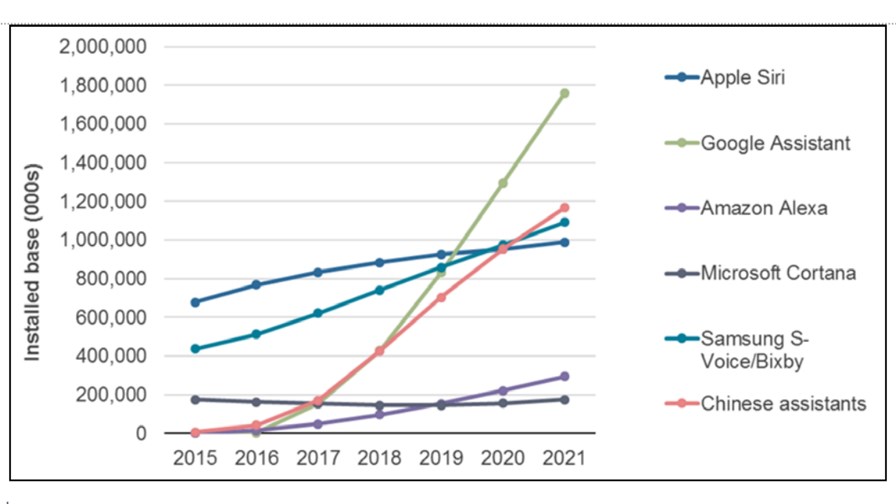
Digital assistant installed base by brand, 2015–21 Source: Ovum
- Digital assistants will outnumber humans by 2021
- Most of them will be on phones and tablets
- But the better engagement will be forged on devices - TVs, speakers, settop boxes etc
The number of digital assistants worldwide will total more than 7.5 billion by 2021 - more assistants than the global population being assisted, according to researchers Ovum.
The winning assistant, in what’s turning out to be the crucial competitive market, will be Google Assistant set to dominate the voice AI-capable device market with 23.3 per cent market share, followed by Samsung's Bixby (with 14.5 per cent ), Apple's Siri (with 13.1 per cent), Amazon's Alexa (3.9 per cent), and Microsoft's Cortana with just 2.3 per cent, judging by progress so far.
But while all the focus is currently on the digital assistant devices, such as Google’s smart speakers, this category currently accounts for a very small proportion of the current assistant total. They are all mostly clustered on smartphones and tablets, which together supported 3.5 billion devices in 2016, probably a lot more now.
But it’s the ‘other’ devices that we need to watch. Experience so far suggests that they greatly increase consumer engagement - particularly in the home. So Ovum expects an exponential uptake of voice AI capabilities amongst new devices, including wearable, smart home, and TV devices, with a combined installed base of 1.63 billion active devices in 2021, a tenfold increase on 2016.
Despite all the hype that surrounds AI-capable connected speakers, TV devices (i.e. smart TVs, set-top boxes, and media streamers) offer a larger opportunity, and will account for 57 per cent of that installed base in 2021.
Although most of the AI capabilities will reside on the network rather than in the device, native vendor-led implementations will be critical to gather the contextual and personal data that will feed the AI engines a capability that is expected to be embedded in new devices from both Google and Samsung.
Global penetration is uneven though. At the end of 2016, over 95 per cent of the installed base for Amazon's Alexa and Google Assistant was in North America, compared to 24 per cent for Apple's Siri. By 2021, 47.6 per cent of voice AI-capable devices in use will be in Asia & Oceania. With an active installed base close to 1.2 billion devices in 2021, digital assistants of Chinese origin are set to be as powerful as Apple's Siri or Samsung's Bixby. They already accounted for close to 43 million devices in 2016, led by companies such as Baidu and iFlytek, says Ovum
"Ultimately, a digital assistant is just another user interface. It will only be as good as the ecosystem of devices and services that it is compatible with. Partnerships between tech giants and local service providers will therefore be key differentiators,” says Ronan de Renesse, Practice Leader for Ovum's Consumer Technology team and author of the report.
"There is a disconnect between the 'know-it-all, do-it-all' approach that current digital assistants are aiming toward and the highly personalized virtual assistance experience that consumers have dreams/nightmares about. Whoever can bring personal consumer data in a secure, non-creepy way to digital assistance will be able to bridge that gap and capture most of the opportunity."
Email Newsletters
Sign up to receive TelecomTV's top news and videos, plus exclusive subscriber-only content direct to your inbox.




